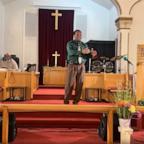Mayan underworld filled with gifts, sacrifices to gods
ACHTUN TUNICHIL MUKNAL CAVE, Belize -- Xibalba was a Maya name for the underworld, home of the gods of death and disease. Caves, not the lofty pyramids left behind by the ancient Maya, were the entrances to Xibalba. And here, in caves like this one, they left sacrifices — plates, bowls and captive's remains — as offerings to the gods.
"One of the things that Maya would do, particularly when they made offerings in caves, was smash things, because to the Maya, things that we consider inanimate, they consider animate. And if you use them in a ritual it was important to smash the vessel to release the spirit," says archaeologist Jaime Awe, director of Belize's Institute of Archaeology. He was standing in the cave before an array of bowls, broken or incised with holes, just as they had been left a thousand years before.
For more than four millennia, Maya conducted rituals in caves like Actun Tunichil Muknal, where Awe led teams to explore starting in 1993. The descendants of the ancient Maya, who abandoned their pyramid-adorned ceremonial centers by 1050 A.D., still perform rituals today in caves in Mexico's Yucatan. In a recent paper in the Latin American Antiquity journal, Awe and colleagues presented evidence from caves like this one that drought played a role in the famed collapse of the ancient Maya. "We've had to map everything in these caves," Awe says.
It wasn't easy. Just getting into this cave requires a creek-crossing hike, a swim through the chill outflow of the cave mouth, a sloshing hike through the river-carved tunnel and then a climb on soft limestone to the auditorium-size grand chamber and beyond, where the bulk of the sacrifices rest. One of the most thrilling tourist's trips around, tours of the cave are led by specially-trained guides past a guarded gate. The lime stone of the cave is so soft that visitors traverse the last part in the socks, so that the oils on the soles of their feet don't erode the floor.
In the study, researchers survey 53 caves in central Belize, such as nearby Chechem Ha Cave, where teams mapped nearly 1000 feet of cave and sifted out a central chamber. They compared charcoal dates left by torches to large jars left behind to find that more elaborate gifts were left at the most intense periods without rain, evidence of a "drought cult," Awe says. "They were asking for more water from caves seen as a water source and home of the gods."



